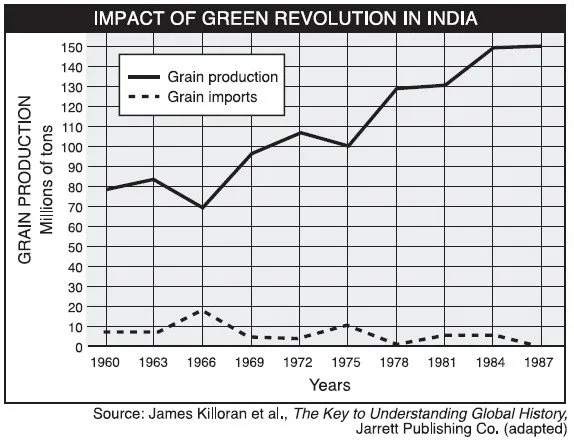-
07 Aug 2024
GS Paper 3
Economy
Day 27: Describe the various agricultural revolutions that occurred in India after independence. How have these revolutions contributed to poverty alleviation and food security in the country? (250 words)
Approach
- Briefly introduce the significance of agricultural revolutions.
- Mention the various agricultural revolutions that occurred in India after independence
- Analyze how these revolutions contributed to poverty alleviation and food security in the country.
- Conclude Suitably.
Introduction
Agricultural revolutions refer to significant and transformative changes in agricultural practices, technologies, and systems that lead to substantial increases in agricultural productivity, efficiency, and sustainability.After independence in 1947, India faced significant challenges in food scarcity and rural poverty. To address these issues, several agricultural revolutions were initiated, transforming the agricultural landscape and enhancing food security.
Body
The various agricultural revolutions that occurred in India after independence :
- Green Revolution (1960s-1980s):
- The Green Revolution was a major initiative that aimed to increase the production and quality of food crops, especially wheat and rice, in India, by introducing new technologies, such as high-yielding varieties of seeds, fertilizers, pesticides, irrigation, and mechanization.
- The Green Revolution led to a significant increase in agricultural productivity. New high-yielding crop varieties, such as dwarf wheat and rice, produced higher yields per hectare of land, helping to meet the growing global demand for food.
- For example, in 1978–1979, a tremendous increase in crop production led to a grain output of 131 million tones, making India one of the largest agricultural producers in the world
- White Revolution (1970s-1990s):
- Launched through Operation Flood, the White Revolution aimed to increase milk production and create a nationwide milk grid.
- The White Revolution was a huge dairy development programme launched in 1970 by the National Dairy Development Board (NDDB) under the direction of Dr. Verghese Kurien, commonly considered the White Revolution's father.
- From 22 million tonnes in 1970 to 187.7 million tonnes in 2018-19, India has become the world's largest milk producer, accounting for 22% of global milk production.
- Yellow Revolution (1980s):
- The Yellow Revolution focused on enhancing the production of oilseeds, particularly mustard and groundnut, to reduce dependency on imported edible oils.
- By promoting new cultivation techniques and establishing support prices, the oilseed production increased significantly, contributing to farmer income and reducing import bills.
- Blue Revolution (1990s-2000s):
- Aimed at increasing fish production, the Blue Revolution promoted aquaculture and sustainable fishing practices.
- It was launched in India during the 7th Five Year Plan (FYP) that went from 1985 to 1990, during which the government sponsored the Fish Farmers Development Agency (FFDA)
- The Indian Fisheries Sector which produced only 60,000 tonnes of fish 50 years ago produces 4.7 million tonnes including 1.6 million tonnes from freshwater aquaculture today.
- Gene Revolution (2000s-Present):
- The Gene Revolution introduced biotechnology and genetically modified (GM) crops to Indian agriculture, aimed at improving crop resilience and yields.
- The introduction of Bt cotton led to a dramatic increase in production across the cotton producing states and soon Bt cotton took over most of the acreage under cotton cultivation. Cotton production rose from 14 million bales in the pre-Bt year of 2001-'02 to 39 million bales in 2014-'15, a rise of almost 180%
Impact of Agricultural Revolutions on Poverty Alleviation in India :
- Higher Income Levels: As agricultural productivity increased, farmers experienced higher incomes from their produce. The rise in income levels enabled farmers to invest in education, healthcare, and other essential needs, improving their overall quality of life.
- Employment Generation: The agricultural revolutions led to the creation of numerous jobs in farming and allied sectors, such as processing, transportation, and marketing. The Green Revolution alone significantly increased employment opportunities in rural areas.
- Diversification of Income Opportunities: The Blue Revolution encouraged fish farming and aquaculture, providing alternative livelihoods for farmers and reducing dependence on traditional crop farming. This diversification helped stabilize incomes and reduce poverty risks.
- Bargaining Power: The White Revolution promoted cooperative dairy farming, empowering smallholder farmers by giving them a stake in the production and marketing processes. This collective approach helped increase their bargaining power and income.
- Access to Resources: The agricultural revolutions facilitated better access to resources, including credit, inputs, and markets, enabling farmers to improve their productivity and incomes.
Impact of Agricultural Revolutions on Food Security in India:
- Tremendous Increase in Crop Produce: It resulted in a grain output of 131 million tonnes in the year 1978-79 and established India as one of the world's biggest agricultural producers.
- In the 1960s, rice yields in India were about two tons per hectare; by the mid-1990s, they had risen to 6 tons per hectare.
- Self-Sufficiency: The increase in food grain production helped India achieve self-sufficiency in staple crops, reducing reliance on food imports and enhancing national food security.
- Diversification of Food Sources : Yellow and Blue Revolutions enhanced the production of oilseeds and fish, respectively, thereby providing a variety of food options and improving overall dietary diversity.
- Public Distribution System (PDS): The surplus food production enabled the government to implement the PDS, ensuring that food is distributed to vulnerable populations at subsidized rates, further enhancing food security for low-income families.
Conclusion
Despite their successes, the agricultural revolutions in India have encountered challenges, including environmental issues like soil degradation and water scarcity due to excessive chemical use. Additionally, benefits have not been evenly distributed, with smallholder farmers struggling to access resources and markets, while increased reliance on hybrid and genetically modified crops has raised concerns about biodiversity.To address these challenges, it is essential to promote sustainable agricultural practices, enhance access to resources for smallholder farmers, and prioritize biodiversity and food sovereignty in agricultural policies.





